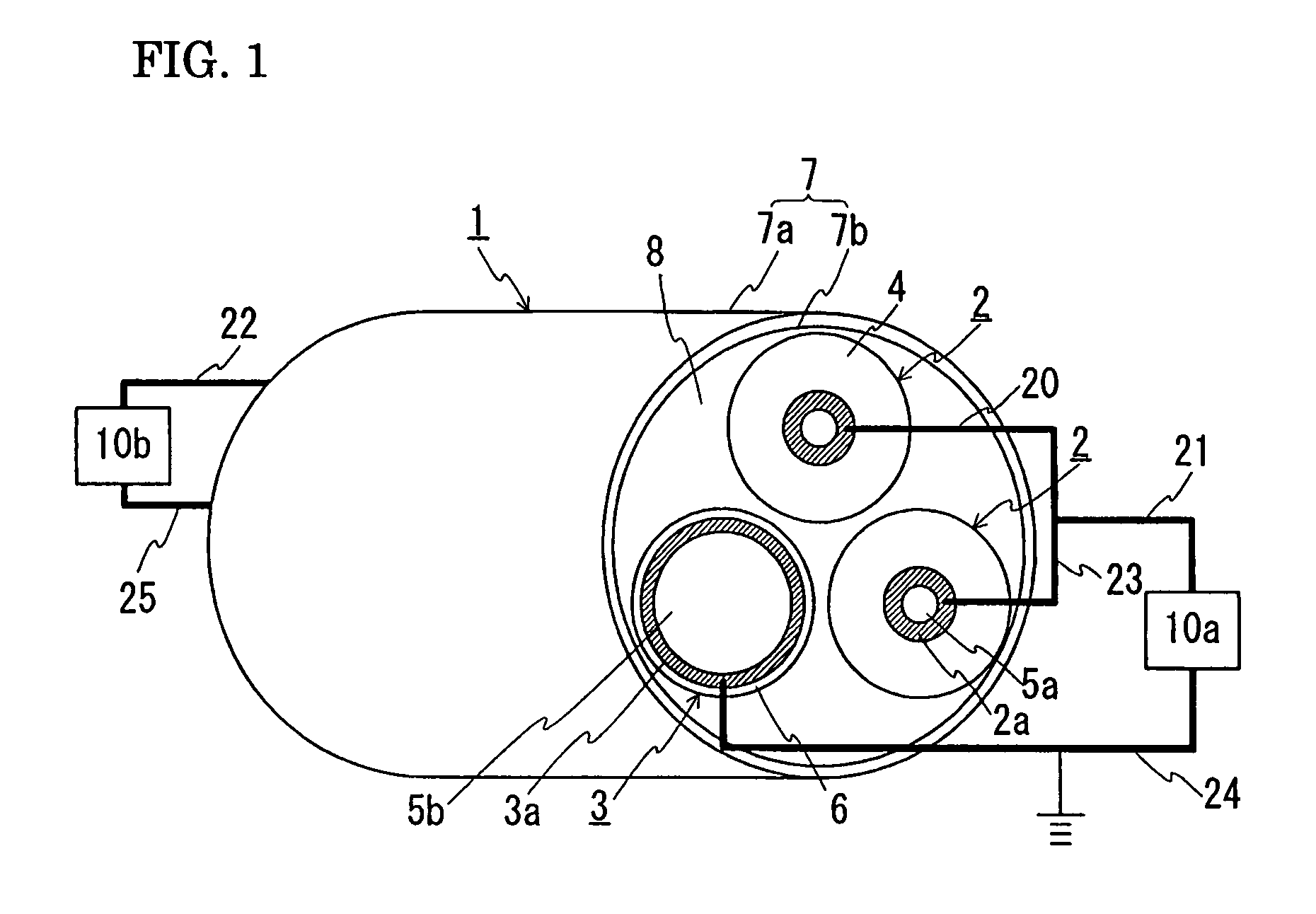Superconducting cable and DC transmission system incorporating the superconducting cable
a superconducting cable and transmission system technology, applied in the direction of superconducting magnets/coils, magnetic bodies, connection contact material, etc., can solve the problem of excessive temperature rise, achieve the effect of reducing the quantity of superconducting material, reducing flexural rigidity, and forming a convenient twisted structur
- Summary
- Abstract
- Description
- Claims
- Application Information
AI Technical Summary
Benefits of technology
Problems solved by technology
Method used
Image
Examples
example 1
[0081]FIG. 1 is a schematic configuration diagram showing a state in which a DC transmission line for unipolar transmission is constructed by using a superconducting cable of the present invention. In the following drawing, the same sign indicates the same item. A superconducting cable 1 is formed by twisting together two types of cores (two first cores 2 and one second core 3) having different structures and then housing the twisted cores in a heat-insulated pipe 7. More specifically, the first cores 2 are each provided with a first superconducting layer 2a composed of a superconducting material at the inner-circumference side of an insulating layer 4 and is not provided with a layer composed of a superconducting material at the outer-circumference side of the insulating layer 4. The second core 3 is provided with a core member 5b at the center-portion side, is provided with a second superconducting layer 3a composed of a superconducting material at the outer-circumference side of ...
example 2
[0090]Next, the case where a bipolar transmission is performed is explained. FIG. 2(A) is a schematic configuration diagram showing a state in which a DC transmission line for bipolar transmission is constructed by using a superconducting cable of the present invention. FIG. 2(B) is a schematic configuration diagram showing a state in which a DC transmission line for unipolar transmission is constructed by using one first core of the two first cores and the second core. The superconducting cable 1 used in Example 1 can also be used for bipolar transmission. To perform the bipolar transmission, it is recommendable to construct a transmission line as shown in FIG. 2(A). More specifically, one end of the first superconducting layer 2a provided in one of the two first cores 2 (in FIG. 2(A), the first core 2 at the top) is connected to a DC-AC converter 11a, which is connected to an AC system (not shown), through a lead 30. The other end of the same first superconducting layer 2a is conn...
example 3
[0097]In the above-described Examples 1 and 2, an explanation is given to the structure in which a stranded copper wire is used as the core member of the second core. However, a coolant-circulating pipe may be used as the core member. FIG. 3 is a schematic cross-sectional view showing a superconducting cable of the present invention that is provided with a coolant-circulating pipe at the inside of the second superconducting layer of the second core. The second core 3 shown in this example has the same basic structure as that shown in Examples 1 and 2. Only the different point is that a coolant-circulating pipe 9a is provided as an inner core member of the core member 5b. An explanation is given below by focusing on this point.
[0098]In this example, the coolant-circulating pipe 9a was formed with a corrugated stainless steel pipe. An insulating layer 9b was formed on the outer circumference of the coolant-circulating pipe 9a by helically lapping semisynthetic insulating layer. In thi...
PUM
| Property | Measurement | Unit |
|---|---|---|
| diameter | aaaaa | aaaaa |
| thickness | aaaaa | aaaaa |
| size | aaaaa | aaaaa |
Abstract
Description
Claims
Application Information
 Login to View More
Login to View More - R&D
- Intellectual Property
- Life Sciences
- Materials
- Tech Scout
- Unparalleled Data Quality
- Higher Quality Content
- 60% Fewer Hallucinations
Browse by: Latest US Patents, China's latest patents, Technical Efficacy Thesaurus, Application Domain, Technology Topic, Popular Technical Reports.
© 2025 PatSnap. All rights reserved.Legal|Privacy policy|Modern Slavery Act Transparency Statement|Sitemap|About US| Contact US: help@patsnap.com



